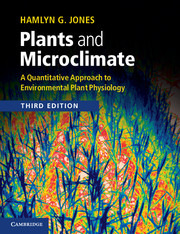Book contents
- Frontmatter
- Contents
- Preface
- Acknowledgements
- Symbols
- Main abbreviations and acronyms
- 1 A quantitative approach to plant–environment interactions
- 2 Radiation
- 3 Heat, mass and momentum transfer
- 4 Plant water relations
- 5 Energy balance and evaporation
- 6 Stomata
- 7 Photosynthesis and respiration
- 8 Light and plant development
- 9 Temperature
- 10 Drought and other abiotic stresses
- 11 Other environmental factors: wind, altitude, climate change and atmospheric pollutants
- 12 Physiology and crop yield improvement
- Appendices
- References
- Index
6 - Stomata
Published online by Cambridge University Press: 05 June 2014
- Frontmatter
- Contents
- Preface
- Acknowledgements
- Symbols
- Main abbreviations and acronyms
- 1 A quantitative approach to plant–environment interactions
- 2 Radiation
- 3 Heat, mass and momentum transfer
- 4 Plant water relations
- 5 Energy balance and evaporation
- 6 Stomata
- 7 Photosynthesis and respiration
- 8 Light and plant development
- 9 Temperature
- 10 Drought and other abiotic stresses
- 11 Other environmental factors: wind, altitude, climate change and atmospheric pollutants
- 12 Physiology and crop yield improvement
- Appendices
- References
- Index
Summary
The evolution of the stomatal apparatus was one of the most important steps in the early colonisation of the terrestrial environment. Even though the stomatal pores when fully open occupy between about 0.5 and 5% of the leaf surface, almost all the water transpired by plants, as well as the CO2 absorbed in photosynthesis, passes through these pores. It is only in rare cases, such as in the fern ally Stylites from the Peruvian Andes, that significant CO2 may be absorbed through the roots (Keeley et al., 1984). The central role of the stomata in regulating water vapour and CO2 exchange by plant leaves is illustrated in Figure 6.1. This figure also shows some of the complex feedback and feedforward control loops that are involved in the control of stomatal apertures and hence of diffusive conductance; these are discussed in Section 6.6.1. It is the extreme sensitivity of the stomata to both environmental and internal physiological factors that enables them to operate in a manner that optimises the balance between water loss and CO2 uptake.
This chapter outlines the fundamental aspects of stomatal physiology, their occurrence in plants, their morphology, their response to environmental factors and mechanics of operation, including a description of the various control loops illustrated in Figure 6.1. The role of the stomata in the control of photosynthesis and of water loss is discussed in more detail in Chapters 7 and 10.
Information
- Type
- Chapter
- Information
- Plants and MicroclimateA Quantitative Approach to Environmental Plant Physiology, pp. 122 - 152Publisher: Cambridge University PressPrint publication year: 2013
Accessibility standard: Unknown
Why this information is here
This section outlines the accessibility features of this content - including support for screen readers, full keyboard navigation and high-contrast display options. This may not be relevant for you.Accessibility Information
- 1
- Cited by
